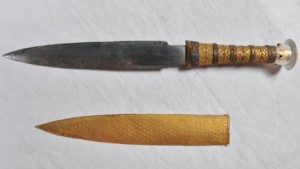The online portal of the International Business Times presented their list of the most significant archaeological discoveries for 2017. The author of the piece, Aristos Georgiou lists the sites 11 most significant digs for the year that is coming to an end. Here is the list:
Lost city founded by Alexander the Great uncovered in Iraq after 2,000 years
A city thought to have been founded by Alexander the Great – known as Qalatga Darband – was uncovered by archaeologists from the British Museum in northern Iraq after being lost for more than 2,000 years.
The hidden remains of the settlement were identified using drones fitted with cameras. The images taken were analysed, allowing researchers to identify the outlines of a large building concealed beneath grain fields. This in turn enabled them to determine the exact location of the remains of the ancient city.Scientists reveal the age of Jesus Christ’s tomb is much older than previously thought
For the first time scientists were able to date what is believed to be the tomb of Jesus Christ – a limestone cave in the Church of the Holy Sepulchre in Jerusalem – revealing that the holy site is much older than previously thought.
The researchers found that the tomb was around 1,700 years old, dating it to around 345 CE. Previous evidence had suggested that the site was no older than 1,000 years old. The cave is widely considered to be the site of Jesus’ crucifixion, burial, and resurrection.
3,000-year-old castle discovered at the bottom of the biggest lake in Turkey
Divers discovered the ruins of a 3,000-year-old castle hidden deep under the waters of Lake Van – the largest lake in Turkey.
The fortress most likely belonged to the Urartian civilisation, an Iron Age kingdom in the Armenian highlands that spanned modern-day Turkey, Armenia and Iran. It was discovered by a team of researchers who have been studying the lake for nearly 10 years.
50,000-year-old ‘Atlantis of the South’ discovered in Australia
The earliest known human settlements in Australia were discovered submerged under the sea. An unprecedented find of bones and artefacts were found in a cave on the coast of Barrow Island, which lies about 50km off the mainland.
The remains are evidence of the first wave of human migration to Australia some 50,000 years ago. Much of the land inhabited by the first Aboriginal people of Australia is now deep underwater.
Tutankhamun’s dagger and other Bronze age artefacts were made from iron brought to Earth on meteorites
Researchers discovered that a number of extremely rare iron objects dating from around 2,000 years before the start of the Iron Age – including a dagger belonging to King Tutankhamun – were not forged from iron-ore found on Earth.
Instead, these ancient artefacts were made from iron originating in meteorites which crashed into our planet thousands of years ago.
Mysterious stone slab discovered in Spain is covered with ancient symbols that no one can read
When researchers examined the stela of Montoro – a large stone slab discovered in Spain that is thought to date from the Iron Age – as part of a recent study, they were puzzled because it was covered in symbols that no one was able to identify.
The slab was first unearthed by a farmer ploughing his field in Montoro, southern Spain, in 2002 who dumped it in a heap of other stones at the side of the field. Two years later, rangers from the regional government’s environmental department discovered it and noticed a series of strange markings covering one of its sides.
Ancient Roman temple which was once the size of St Paul’s Cathedral discovered in Italy
The remains of a huge Roman temple, as big as St Paul’s Cathedral in London, was discovered by a Cambridge University archaeological team in central Italy. The sacred site was uncovered several feet below Falerii Novi, an abandoned town around 30 miles north of Rome.
The temple is believed to cover an area measuring 120m long and 60m wide. The findings have provided new insights into a period of Roman expansion and urbanisation in Italy.
1,000-year-old massive, perfectly circular Viking fortress discovered in Denmark
Archaeologists uncovered the remains of a spectacular 10th century Viking fortress south of Copenhagen, shaped in a perfect circle – the first of its kind to be found in Denmark for 60 years.
The structure is a known as a Trelleborg fortress – a type of defensive structure which has a distinctive overall shape and internal structure.
Giant hidden void discovered deep inside Egypt’s Great Pyramid of Giza
A huge, hidden void was uncovered deep inside the Great Pyramid of Giza with the help of a state-of-the-art imaging system which can ‘see’ through stone.
An international team of researchers identified a large internal cavity at least 30 metres long above the Grand Gallery – a steeply slanted passageway which connects two other chambers, known as the ‘Queen’s Chamber’ and the ‘King’s Chamber’.
Giant underwater goddess found off Turkish coast in ancient shipwreck
A giant goddess sculpture was found on the sea floor off the south-western coast of Turkey. Experts said it was the largest of its kind ever discovered in Turkish waters.
The 2,700-year-old artefact was found by archaeologists investigating the contents of a 43m deep shipwreck uncovered in November 2016. Presently they had only located the legs and feet of the Cypriot goddess – now the race is on to find her upper half.
First archaeological evidence of Julius Caesar’s invasion of Britain discovered
Researchers discovered the first archaeological evidence of Julius Caesar’s invasion of Britain suggesting that the Roman emperor’s fleet landed at Pegwell Bay on the Isle of Thanet in Kent.
The findings suggest that the emperor’s campaigns shaped the history of Britain more than previously thought and that Emperor Claudius exploited Caesar’s legacy when he conducted his more comprehensive invasion of Britain nearly 100 years later in 43 AD. That campaign resulted in the permanent Roman settlement of England, Wales, and parts of Scotland.source: ibtimes.co.uk
Ask me anything
Explore related questions
















